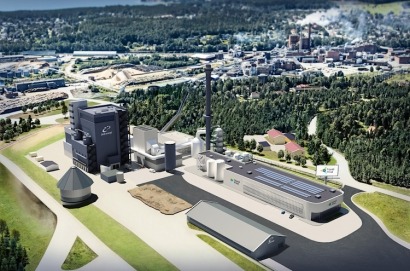
Danish energy company Ørsted is building Europe’s largest commercial production facility for carbon-neutral marine fuels in northeastern Sweden. At the heart of the FlagshipONE plant is a technology package from Siemens Energy comprising four proton exchange membrane (PEM) electrolyzers with a total capacity of 70 megawatts, as well as the plant-wide electrification and automation systems, including innovative digitalization solutions (such as the use of digital twins), and the entire power distribution and compressor systems.
The plant, which is being built in the Swedish coastal town of Örnsköldsvik, will be able to produce up to 50,000 metric tons of e-methanol per year from renewable energy and biogenic carbon dioxide from 2025. As a substitute for fossil fuels, this can avoid 100,000 tons of CO2 emissions per year in shipping.
Ørsted’s plant represents the start of commercial production of carbon neutral e-methanol in Europe, based on a unique approach. Instead of building bespoke plants at each location, FlagshipONE will act as a blueprint – a “copy-and-paste” model – that can be scaled and replicated at other locations, in Sweden and elsewhere.
The standardization approach has been created by the Swedish company Liquid Wind AB, the original developer of FlagshipONE. Liquid Wind develops replicable facilities to produce e-fuel and has plans to develop at least ten facilities in Scandinavia by 2030.
As a partner to Liquid Wind, Siemens Energy plays a significant part in developing and progressing this trailblazing concept and provides the framework for turning these e-fuel facilities into reality with its technology package.
FlagshipONE uses renewable electricity to produce green hydrogen, using Siemens Energy electrolyzers. A further stage in the synthesis process brings in biogenic carbon dioxide from a nearby biomass-fired combined heat and power station.
The resulting e-methanol is a CO2-neutral electrofuel that is easy to store and transport. The e-methanol from FlagshipONE will be used in state-of-the-art “dual-fuel” ship engines, either alone or as an admixture to conventional fuel, and contribute towards the decarbonization of international maritime transportation, which accounts for three percent of global carbon emissions.
Green fuels are currently unavailable in sufficient volumes and the cost is significantly above fossil fuel. This is where FlagshipONE comes in. The plant provides a blueprint for modular e-methanol plants to ramp up the industry in a way that is both flexible and market-oriented, and to enable experience that can be fed into the ongoing improvement of existing and new plants using the digital-twin concept.
The next plant, FlagshipTWO, is already being developed by Liquid Wind and will be able to supply 100,000 metric tons of e-methanol to the market using a 140-MW capacity electrolyzer.